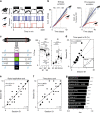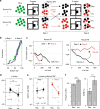Social interactions impact on the dopaminergic system and drive individuality
- PMID: 30082725
- PMCID: PMC6079008
- DOI: 10.1038/s41467-018-05526-5
Social interactions impact on the dopaminergic system and drive individuality
Abstract
Individuality is a striking feature of animal behavior. Individual animals differ in traits and preferences which shape their interactions and their prospects for survival. However, the mechanisms underlying behavioral individuation are poorly understood and are generally considered to be genetic-based. Here, we devised a large environment, Souris City, in which mice live continuously in large groups. We observed the emergence of individual differences in social behavior, activity levels, and cognitive traits, even though the animals had low genetic diversity (inbred C57BL/6J strain). We further show that the phenotypic divergence in individual behaviors was mirrored by developing differences in midbrain dopamine neuron firing properties. Strikingly, modifying the social environment resulted in a fast re-adaptation of both the animal's traits and its dopamine firing pattern. Individuality can rapidly change upon social challenges, and does not just depend on the genetic status or the accumulation of small differences throughout development.
Conflict of interest statement
The authors declare no competing interests.
Figures





References
-
- Duckworth RA. Evolution of personality: developmental constraints on behavioral flexibility. Auk. 2010;127:752–758. doi: 10.1525/auk.2010.127.4.752. - DOI
Publication types
MeSH terms
Substances
Grants and funding
- DEQ2013326488/Fondation pour la Recherche Médicale (Foundation for Medical Research in France)/International
- Coup d'Elan 2012/Fondation Bettencourt Schueller (Bettencourt Schueller Foundation)/International
- TABAC-16-022/Institut National Du Cancer (French National Cancer Institute)/International
- ANR-11-IDEX-0004-02/Agence Nationale de la Recherche (French National Research Agency)/International
LinkOut - more resources
Full Text Sources
Other Literature Sources
Molecular Biology Databases

